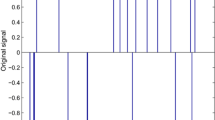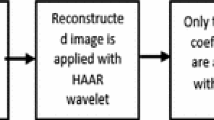Abstract
This paper addresses the analog optimization for non-differential functions. The Lagrange programming neural network (LPNN) approach provides us a systematic way to build analog neural networks for handling constrained optimization problems. However, its drawback is that it cannot handle non-differentiable functions. In compressive sampling, one of the optimization problems is least absolute shrinkage and selection operator (LASSO), where the constraint is non-differentiable. This paper considers the hidden state concept from the local competition algorithm to formulate an analog model for the LASSO problem. Hence, the non-differentiable limitation of LPNN can be overcome. Under some conditions, at equilibrium, the network leads to the optimal solution of the LASSO. Also, we prove that these equilibrium points are stable. Simulation study illustrates that the proposed analog model and the traditional digital method have the similar mean squared performance.







Similar content being viewed by others
References
Cichocki A, Unbehauen R (1993) Neural networks for optimization and signal processing. Wiley, London
MacIntyre J (2013) Applications of neural computing in the twenty-first century and 21 years of Neural Computing & Applications. Neural Computing Appl 23(3):657–665
Hopfield JJ (1982) Neural networks and physical systems with emergent collective computational abilities. In: Proceedings of the National Academy of Sciences, 79, 2554–2558
Tank D, Hopfield JJ (1986) Simple neural optimization networks: an A/D converter, signal decision circuit, and a linear programming circuit. IEEE Trans Circuits Syst 33(5):533–541
Duan S, Dong Z, Hu X, Wang L, Li H (2016) Small-world Hopfield neural networks with weight salience priority and memristor synapses for digit recognition. Neural Computing Appl 27(4):837–844
Chua LO, Lin GN (1984) Nonlinear programming without computation. IEEE Trans Circuits Syst 31:182–188
Liu Q, Wang J (2008) A one-layer recurrent neural network with a discontinuous hard-limiting activation function for quadratic programming. IEEE Trans Neural Netw 19(4):558–570
Wang J (2010) Analysis and design of a k-winners-take-all model with a single state variable and the heaviside step activation function. IEEE Trans Neural Netw 21(9):1496–1506
Bharitkar S, Tsuchiya K, Takefuji Y (1999) Microcode optimization with neural networks. IEEE Trans Neural Netw 10(3):698–703
Chua LO, Yang L (1988) Cellular neural networks: theory. IEEE Trans Circuits Syst 35(10):1257–1272
Ho TY, Lam PM, Leung CS (2008) Parallelization of cellular neural networks on GPU. Pattern Recognit 41(8):2684–2692
Lin YL, Hsieh JG, Kuo YS, Jeng JH (2016) NXOR- or XOR-based robust template decomposition for cellular neural networks implementing an arbitrary Boolean function via support vector classifiers. Neural Computing Appl (accepted)
Liu X (2016) Improved convergence criteria for HCNNs with delays and oscillating coefficients in leakage terms. Neural Computing Appl 27(4):917–925
Sum J, Leung CS, Tam P, Young G, Kan WK, Chan LW (1999) Analysis for a class of winner-take-all model. IEEE Trans Neural Netw 10(1):64–71
Liu S, Wang J (2006) A simplified dual neural network for quadratic programming with its KWTA application. IEEE Trans Neural Netw 17(6):1500–1510
Xiao Y, Liu Y, Leung CS, Sum J, Ho K (2012) Analysis on the convergence time of dual neural network-based kwta. IEEE Trans Neural Netw Learn Syst 23(4):676–682
Gao XB (2003) Exponential stability of globally projected dynamics systems. IEEE Trans Neural Netw 14:426–431
Hu X, Wang J (2007) A recurrent neural network for solving a class of general variational inequalities. IEEE Trans Syst Man Cybern B Cybern 37(3):528–539
Zhang S, Constantinidies AG (1992) Lagrange programming neural networks. IEEE Tran Circuits Syst II 39:441–452
Leung CS, Sum J, So HC, Constantinides AG, Chan FKW (2014) Lagrange programming neural networks for time-of-arrival-based source localization. Neural Computing Appl 24(1):109–116
Liang J, So HC, Leung CS, Li J, Farina A (2015) Waveform design with unit modulus and spectral shape constraints via Lagrange programming neural network. IEEE J Sel Top Signal Process 9(8):1377–1386
Liang J, Leung CS, So HC (2016) Lagrange programming neural network approach for target localization in distributed MIMO radar. IEEE Trans Signal Process 64(6):1574–1585
Donoho DL, Elad M (2003) Optimally sparse representation in general (nonorthogonal) dictionaries via \(l_1\) minimization. Proc Natl Acad Sci 100(5):2197–2202
Gilbert AC, Tropp JA (2005) Applications of sparse approximation in communications. In: Proceedings of the international symposium on information theory ISIT 2005:1000–1004
Sahoo SK, Lu W(2011) Image denoising using sparse approximation with adaptive window selection. In: Proceedings of the 8th international conference on information, communications and signal processing (ICICS) 2011, 1–5
Rahmoune A, Vandergheynst P, Frossard P (2012) Sparse approximation using m-term pursuit and application in image and video coding. IEEE Trans Image Process 21(4):1950–1962
Kim SJ, Koh K, Lustig M, Boyd S, Gorinevsky D (2007) An interior-point method for large-scale ‘1-regularized least squares. IEEE J Sel Top Sig Proc 1(4):606–617
Saunders MA (2005) Matlab software for convex optimization. http://www.stanford.edu/group/SOL/software/pdco.html
Figueiredo M, Nowak R, Wright S (2007) Gradient projection for sparse reconstruction: application to compressed sensing and other inverse problems, IEEE. J Sel Top Sig Proc 1(4):586–597
Berg E, Friedlander MP (2008) Probing the pareto frontier for basis pursuit solutions. SIAM J Sci Computing 31(2):890912
Berg E, Friedlander MP (2011) Sparse optimization with least-squares constraints. SIAM J Optim 21(4):1201–1229
Berg E, Friedlander MP (2007) SPGL1: a solver for large-scale sparse reconstruction. http://www.cs.ubc.ca/labs/scl/spgl1
Rozell CJ, Johnson DH, Baraniuk RG, Olshausen BA (2008) Sparse coding via thresholding and local competition in neural circuits. Neural Comput 20(10):2526–2563
Chen SS, Donoho DL, Saunders MA (1998) Atomic decomposition by basis pursuit. SIAM J Sci Comput 20(1):33–61
Feng R, Lee CM, Leung CS (2015) Lagrange programming neural network for the L1-norm constrained quadratic minimization. In: Proceedings of the ICONIP 2015, Istanbul, Turkey, 3, pp 119–126
Balavoine A, Rozell CJ, Romberg J (2011) Global convergence of the locally competitive algorithm. In: Proceedings of the IEEE signal processing education workshop (DSP/SPE) (2011) Sedona. Arizona, USA, pp 431–436
Balavoine A, Romberg J, Rozell CJ (2012) Convergence and rate analysis of neural networks for sparse approximation. IEEE Trans Neural Netw Learn Syst 23(9):1377–1389
Gordon G, Tibshirani R (2012) Karush–Kuhn–Tucker conditions, Optimization Fall 2012 Lecture Notes
Guenin B, Konemann J, Tunel T (2014) A gentle introduction to optimization. Cambridge University Press, Cambridge
Feng X, Zhang Z (2007) The rank of a random matrix. Appl Math Comput 185(1):689–694
Acknowledgements
This work is partially supported by the Research Grants Council, Hong Kong, under Grant Number, CityU 115612.
Author information
Authors and Affiliations
Corresponding author
Ethics declarations
Conflict of interest
Authors declare that they do not have any commercial or associative interest that represents a conflict of interest in connection with the work submitted.
Rights and permissions
About this article
Cite this article
Wang, H., Lee, C.M., Feng, R. et al. An analog neural network approach for the least absolute shrinkage and selection operator problem. Neural Comput & Applic 29, 389–400 (2018). https://doi.org/10.1007/s00521-017-2863-5
Received:
Accepted:
Published:
Issue Date:
DOI: https://doi.org/10.1007/s00521-017-2863-5




